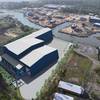Secretary of the Navy (SECNAV), the Honorable Donald C. Winter tours an automated robotic welding facility at the A.P. Moller-Maersk’s Odense Steel Shipyard. SECNAV was in Denmark to get a first-hand look at how foreign shipyards design and produce Naval warships. U.S. Navy photo by Chief Mass Communication Specialist Shawn P. Eklund
Secretary of the Navy (SECNAV) Donald C. Winter toured A.P. Moller-Maersk's Odense Steel Shipyard on Feb. 20 to see how the company -- which historically builds large commercial shipping units -- transitioned into the Danish defense industry.
“I wanted to get an idea of how a foreign commercial shipbuilder designed and constructed a lead warship -- on budget and on time,” said Winter.
Winter's trip included a corporate overview and tour of the industrial manufacturing plant at the shipyard on the east coast of Denmark. During the tour, Winter had a chance to see some of the advanced automated systems in use by the shipyard.
The senior vice president of sales and purchasing, Christian Rodin-Nielsen, explained that the use of industrial robotics is one of the many ways Maersk has led the industry in advanced ship construction. The robotic welding significantly reduced their manpower requirements and provided their customers with a high quality product at a lower cost.
Winter also received a brief on the company's design and technology facility. The facility allows for collaboration between Maersk's six yards in several Baltic nations and eliminates unnecessary rework when component parts from these yards come together for final assembly.
Following his shipyard visit, Winter saw firsthand the quality of warships the company is producing when he was invited aboard the Royal Danish Navy (RDN) ship, L16 Absalon, later that day.
Absalon is the first in its class of flexible support ships. Similar to the U.S. Navy's littoral combat ship (LCS), the Absalon and the other ships of the class are designed to use modularity and scalability to perform a wide variety of missions in support of national and international tasking. These missions include transportation of personnel and material; command and control for land, air and sea operations; and a spectrum of warfare specialties like air defense and anti-submarine warfare. The ship also has the capacity to carry out humanitarian operations as a hospital ship.
While visiting Absalon, Winter had the opportunity to see the various modules designed for the ship. The modules are all self-contained, 10-foot cubes which contain entire warfighting systems. Utilizing plug and play technology, Danish sailors can change a module on Absalon within an hour, providing the RDN tremendous flexibility and capability at a low cost, explained the Danish Chief of Naval Operations Nils Wang.
Since becoming the SECNAV, Winter has visited all the major shipbuilders in the United States to further his understanding of the shipbuilding industry and see best practices. His visit to Maersk and the RDN are in line with this effort.
“There is much we can learn from the Danish navy and Danish shipbuilders with regard to modularity and ship construction,” explained Winter. “I was impressed with the rigorous and disciplined manner in which the Flexible Support ships are designed, manufactured and operated. There are definitely lessons here we can use in the U.S.”
By Chief Mass Communication Specialist Shawn P. Eklund, Secretary of the Navy Public Affairs
Sponsored Content
Maritime leaders unite to tackle ocean plastic with launch of new alliance: the Maritime Association for Clean Seas

ABS Wavesight Advantage™: One Intelligent, Connected Maritime Platform to Transform Complexity into Operational Clarity

Subscribe for
Maritime Reporter E-News
Maritime Reporter E-News is the maritime industry's largest circulation and most authoritative ENews Service, delivered to your Email five times per week









